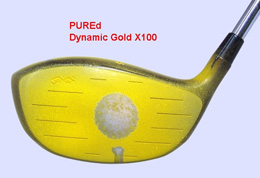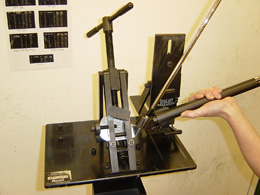PURE shafts - the ultimate custom-fit
We simplify the latest 'must have' technology on Tour

 |  | |
Arguably, the ultimate custom-fitting process, shaft ‘Pureing’ has swept the professional Tours around the world and is now even available to all golfers prepared to pay the price for 'perfect' equipment. It has been controversially golf’s most mysterious equipment secret over the last few years and now some 200 top golfers have adopted the technology - with those tell-tale gold SST Pure stickers on the shafts of many winners. The simplest definition is to say that pureing is the high-tech process of carefully aligning each shaft in its respective clubhead to reduce any distortion almost inevitable in its construction. Named after company that pioneered it (SST Pure), the technique has emerged in response to the reality that, despite modern manufacturing methods, it is virtually impossible to make a golf shaft that is perfectly symmetrical in cross section throughout its length. | ||
You only need to look though a batch of raw shafts to see how wall thicknesses vary - however minuscule to the naked eye - across the diameter. So it's not rocket science to grasp that any individual shaft flexes slightly differently according to how it is aligned in the hosel. But while skeptics claim the ‘Pure-ists’ are merely splitting hairs, the USGA were so impressed by the presentation made by SST founder, Dick Weiss to its Ball and Implements committee nine years ago, that they changed the Rules Of Golf to legalise and embrace the Pureing process. |  | |
 | With just a handful of off-the-shelf shafts, Weiss demonstrated how a 'dodgy' shaft flex can perform, implying anything from Extra Stiff to Ladies, simply based on the position it is inserted into the hosel at the factory stage. Crucially, the problem is not confined to graphite shafts, nor to budget or even ‘rogue’ manufacturers. Many of Weiss’s worst examples were steel shafts from major brands. | |
Now the Pureing concept has steadily caught the imagination of Tour pros and their technicians who leave nothing to chance. “Any time something can improve my game and I don’t have to do anything [change my technique] I’d be foolish not to Pure my clubs,” says Open champion Padraig Harrington, who won’t even experiment with a new club on the practice ground unless it has been pre-Pure’d. The technology came of age in 2007 when Pure’d shafts claimed two majors. Angel Cabrera (US Open) joined Harrington among the converts which now span legends like Jack Nicklaus, Arnold Palmer and Greg Norman through to current stars such as Jim Furyk and Darren Clarke. | ||
| Indeed, over half of the top-20 finishers at this year’s US Masters played with Pure’d clubs, while the $50 million in prize money won collectively by Pure’d US PGA Tour players in 2008 tells its own story. Currently there's no SST Pure facility at European Tour events, which leaves its pros’ Pureing demands required to be channeled through one of only three UK licensees. Not to be confused with 'frequency matching', which strives for shaft flex consistency throughout a set of clubs, ‘Pureing’ is solely concerned with getting the most consistent performance out of a single shaft by minimising the random oscillations which inevitably occur. These movements can best be appreciated by studying the accompanying photographs showing the different pattern of face markings on a driver (fitted with the same shaft in two different orientations) captured during an independent mechanical robot test. | ||
| Given the robot’s repeating swing, you’d expect the markings to be identical for any given shaft no matter how you aligned it. However, the un-Pure’d pattern confirms the randomly-inserted shaft is not delivering the head to the golf ball quite as consistently. While the performance differences may be negligible, equally they have the potential to be dramatic. The trouble is, you just can’t tell. Many golfers persevere unaware that at least some element of their bad shots may well be down to their equipment rather than just their swing. |  | |
 | Costs can vary but, for example, to Retro-pure a shaft (take it out of an existing clubhead, check it, re-grip it and re-assemble it) costs around £35-£40 including a new grip. To fit a set of eight pre-pured shafts can cost from £350-£400 plus grips. However, Pureing is not an instant cure for your shaft ills, as even independent custom-fitting specialists acknowledge. | |
| “Pureing is not a substitute for the correct fitting of shaft flex, bend profile and weight, which remain essential stages of the custom-fitting process,” says Simon Cooper of Precision Golf, one of only three UK custom fitting operations licensed to offer SST Pure technology. “But it is an increasingly popular addition to the club-building process for all standards of golfer. It ensures that a correctly chosen shaft performs in a way that is more predictable and repeatable,” he adds, referring to the greater dynamic stability of the golf club, especially in the transition from backswing to downswing. The Pureing process itself involves measuring a shaft’s frequency variation (the profile of vibrations around a shaft’s circumference) using highly-sensitive sensors, while SST Pure’s elaborate software locates the most neutral orientation, or ‘Plane of Uniform REpeatability’ (PURE). The shaft is then carefully aligned by the club builder into the head in a process that takes some 15 minutes per shaft. Ultimately, for all the technical justification, there’s no doubt that the rise of Pureing is partly down to the way it taps into the psychology of today’s sporting perfectionists. As the icing on the cake in a complete custom-fitting makeover, it dispels any element of technical doubt. It reassures the golfer that their clubs have been set-up to the most precise specifications, leaving them free to focus on that other elusive component - a pure golf swing. For more information on Pureing, contact:
| ||

